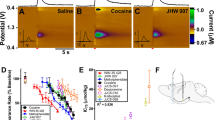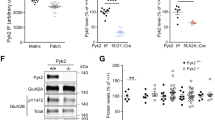Abstract
It is clear that morphine markedly increases the turnover of dopamine (DA) in the rat striatum1–3, although the nature of this increase remains obscure. The early suggestion, that morphine may block postsynaptic DA receptors in a similar manner to haloperidol4, has since been refuted5,6. The effect of morphine on dopaminergic neurones seems to be presynaptic, but whether it stimulates7,8 or inhibits2,5 the functional activity of the dopaminergic neurones is unclear. We recently reported that morphine seems to have no effect on the functional activity of the nigrostriatal dopaminergic neurones, using the decline in DA after administration of α-methyl-p-tyrosine (αMT) as a measure of DA efflux9,10. However, the substantia nigra and striatum are extremely rich in opiate receptors11,12, and a considerable number of the striatal opiate receptors seem to be localised on dopaminergic nerve endings13; it would therefore be rather surprising if stimulation of these receptors by morphine did not alter the functional activity of the nigrostriatal dopaminergic neurones. To investigate this apparent discrepancy, we analysed the effect of morphine on DA efflux in conditions of altered impulse flow in the nigrostriatal dopaminergic neurones. The present results show that the administration of morphine results in increased efflux of DA from neurones with a lowered firing rate, but not from neurones with a normal or increased firing rate. Thus, morphine may be a modulator of the nigrostriatal dopaminergic neurones in that it counteracts decreasing dopaminergic activity, but has no effect when the activity is normal or increased.
This is a preview of subscription content, access via your institution
Access options
Subscribe to this journal
Receive 51 print issues and online access
$199.00 per year
only $3.90 per issue
Buy this article
- Purchase on Springer Link
- Instant access to full article PDF
Prices may be subject to local taxes which are calculated during checkout
Similar content being viewed by others
References
Clouet, D. H. & Ratner, M. Science 168, 854–856 (1970).
Kuschinsky, K. & Hornykiewicz, O. Eur. J. Pharmac. 19, 119–122 (1972).
Westerink, B. H. C. & Korf, J. Eur. J. Pharmac. 38, 281–291 (1976).
Puri, S. K., Reddy, C. & Lal, H. Res. Commun. chem. Path. Pharmac. 5, 389–401 (1973).
Carenzi, A., Guidotti, A., Revuelta, A. & Costa, E. J. Pharmac. exp. Ther. 194, 311–318 (1975).
Carenzi, A., Cheney, D. L., Costa, E., Guidotti, A. & Racagni, G. Neuropharmacology 14, 927 (1975).
Moleman, P., Versluis, D. J. & Bruinvels, J. Psychopharmacologia 60, 35–39 (1978).
Pert, A. in Characteristics and Function of Opioids (eds Van Ree, J. M. & Terenius, L.) 389–401 (Elsevier, Amsterdam, 1978).
Moleman, P. & Bruinvels, J. Life Sci. 19, 1277–1282 (1976).
Moleman, P. & Bruinvels, J. Prog. Neuro-Psychopharmac. 1, 101–106 (1977).
Kuhar, M. J., Pert, C. B. & Snyder, S. H. Nature 245, 447–450 (1973).
Snyder, S. H. Nature 257, 185–189 (1975).
Pollard, H., Llorens-Cortes, C. & Schwartz, J. C. Nature 268, 745–747 (1977).
Gispen, W. H., Schotman, P. & De Kloet, E. R. Neuroendocrinology 9, 285–296 (1972).
Aghajanian, G. K. & Bunney, B. S. in Frontiers in Catecholamine Research (eds Usdin, E. & Snyder, S. H.) 643–648 (Pergamon, Oxford, 1973).
Doteuchi, M., Wang, G. & Costa, E. Molec. Pharmac. 10, 225–234 (1974).
Papeschi, R. Psychopharmacology 55, 1–7 (1977).
DiChiara, G. et al. Adv. biochem. Psychopharmac. 16, 571–575 (1977).
Lee, C. M., Wong, P. C. L. & Chan, S. H. H. Neuropharmacology 16, 571–576 (1977).
Ahtee, L., Garcia-Sevilla, J. A., Magnusson, T. & Carlsson, A. in Characteristics and Function of Opioids (eds Van Ree, J. M. & Terenius, L.) 345 (Elsevier, Amsterdam, 1978).
Algeri, S., Calderini, G., Consolazione, A. & Lomuscio, G. in Characteristics and Function of Opioids (eds Van Ree, J. M. & Terenius, L.) 347 (Elsevier, Amsterdam, 1978).
Steel, R. G. D. & Torre, J. H. Principles and Proceedings of Statistics (McGraw-Hill, New York, 1960).
Author information
Authors and Affiliations
Rights and permissions
About this article
Cite this article
Moleman, P., Bruinvels, J. Morphine-induced striatal dopamine efflux depends on the activity of nigrostriatal dopamine neurones. Nature 281, 686–687 (1979). https://doi.org/10.1038/281686a0
Received:
Accepted:
Issue Date:
DOI: https://doi.org/10.1038/281686a0
This article is cited by
-
Modulatory Effect of Environmental Context and Drug History on Heroin-Induced Psychomotor Activity and Fos Protein Expression in the Rat Brain
Neuropsychopharmacology (2007)
-
Effects of morphine on dopamine metabolism in rat striatum and limbic structures in relation to the activity of dopaminergic neurones
Naunyn-Schmiedeberg's Archives of Pharmacology (1984)
-
Morphine and δ-opiate agonists locally stimulate in vivo dopamine release in cat caudate nucleus
Nature (1981)
Comments
By submitting a comment you agree to abide by our Terms and Community Guidelines. If you find something abusive or that does not comply with our terms or guidelines please flag it as inappropriate.



